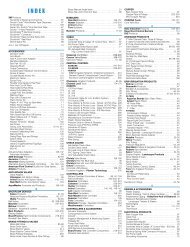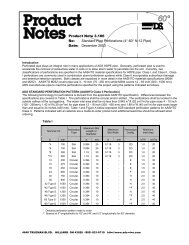LANDSCAPE PRODUCTS 0100 - Ewing Irrigation
LANDSCAPE PRODUCTS 0100 - Ewing Irrigation
LANDSCAPE PRODUCTS 0100 - Ewing Irrigation
Create successful ePaper yourself
Turn your PDF publications into a flip-book with our unique Google optimized e-Paper software.
SOURCE: National Center for Health Statistics, National Vital Statistics System.There were 50.6 births for every 1,000 unmarried women ages 15–44 in 2009. 10Between 1980 and 1994, the birth rate for unmarried women ages 15–44 increased from 29.4 to 46.2 per 1,000. Between1995 and 2002, the rate fluctuated little, ranging from 42.9 to 44.3 per 1,000; from 2002 to 2008, however, the rate increased8, 10, 11from 43.7 to 52.5 per 1,000, before declining to 50.6 per 1,000 in 2009.Rates in 2008 remained highest for women ages 20–24 (79.2 per 1,000), followed closely by the rate for women ages 25–296, 12(76.1 per 1,000).The birth rate among unmarried adolescents ages 15–19 declined between 1994 and 2005, increased in 2006 and 2007, andthen decreased slightly in 2008. Among adolescent subgroups, the rate for adolescents ages 15–17 declined from 31.7 per1,000 in 1994 to 19.7 in 2005 and has changed little since (it was 20.6 in 2008). For adolescents ages 18–19, the birth ratedeclined from 1994 to 2003 and increased annually from 2003 to 2007; the rate declined in 2008, when it was 61.9 per 1,000.Birth rates for unmarried women in their twenties changed relatively little during the mid- to late 1990s. In the 2000s, for womenages 20–24, the rate rose from 70.5 per 1,000 in 2002 to 79.2 in 2008, and, for women ages 25–29, the rate rose from 58.5 per1,000 in 2000 to 76.1 in 2008. Birth rates for unmarried women ages 30–44 have steadily increased since the late 1990s.The proportion of women of childbearing age who were unmarried continued to rise to over half in 2009. However,nonmarital cohabitation has remained relatively unchanged: nearly 3 in 10 unmarried women ages 25–29 in 2002 were incohabiting relationships. 13Children are at greater risk for adverse consequences when born to a single mother, because the social, emotional, and financialresources available to the family may be limited. 14 The proportion of births to unmarried women is useful for understanding theextent to which children born in a given year may be affected by any disadvantage—social, financial, or health—associated withbeing born outside of marriage. The change in the percentage of births to unmarried women reflects changes in the birth rate forunmarried women relative to the birth rate for married women. 15For footnotes, seehttp://www.childstats.gov/americaschildren/famsoc2.asp
















